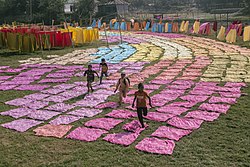Dye
Dye is a substance used to color materials. It is often used to color the fabric used to make clothing. It has low solubility. A pigment won't do this because it won't stick to the fibers of the fabric and color them. A dye can be natural, usually made from plant material such as berries, or a dye can be artificial, meaning that it is made by humans from chemicals such as petrochemicals.
Most natural dyes are gotten from different parts of a plant like the roots, fruits, bark, leaves, wood, fungi and lichens.[1] Most dyes are synthetic and are made from petrochemicals.[2]
Classification
Dyes can be classified based on their solubility and chemical properties.
- Acid dyes can dissolve in water. They are used on fibers such as silk, wool, nylon. Most food coloring that are made by man are acid dyes. Examples of acid dye are Alizarine Pure Blue B, Acid red 88, etc.
- Basic dyes can dissolve in water. They are mainly used on acrylic fibers. They may also be used on wool and silk. Basic dyes are also used to make paper colourful.
Dye Media
Chemical structure of indigo dye, the blue coloration of blue jeans. Although once extracted from plants, indigo dye is now almost exclusively synthesized industrially.
Dyeing wool cloth, 1482: from a French translation of Bartolomaeus Anglicus
Historical collection of over 10,000 dyes at Technical University Dresden, Germany
RIT brand dye from mid-20th century Mexico, part of the permanent collection of the Museo del Objeto del Objeto
Related pages
References
- ↑ Burgess, Rebecca, 1977- (2011). Harvesting color : how to find plants and make natural dyes. Green, Paige. New York: Artisan. ISBN 978-1-57965-425-2. OCLC 667210526.
{{cite book}}: CS1 maint: multiple names: authors list (link) - ↑ Silfvast, William T. (2008-07-21). Laser Fundamentals. Cambridge University Press. ISBN 978-1-139-85557-0.




